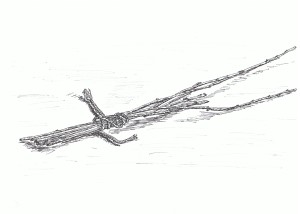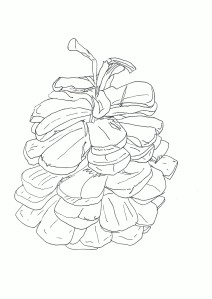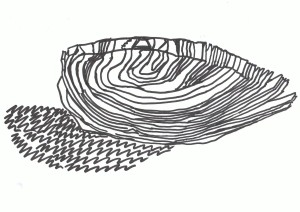Detailed observation project – stipples and dots – attempt 2
Posted: May 28, 2012 Filed under: Detailed observation project - Part Two Leave a commentThis is my second attempt at this exercise. I chose to draw some sticks of willow tied together with a piece of string. There was an interesting texture along the willow, which contrasted with the string. I used a fine artist drawing pen and used a mixture of marks to indicate differences in tone and texture. I used dots along the string to indicate the shadows and a mixture of different marks to show the texture and tone of the willow.
I am not sure I like the result of this drawing. It was more challenging than my first attempt. It was difficult to indicate the difference between form, texture and tone, especially as the willow was quite thin. I am not sure that it is easy to tell the outlines of the willow rods but I was trying to avoid drawing an outline and filling it in as suggested by my previous tutor. I am still having problems with the background.
It has shown me the variation of marks you need to be able to represent tone, texture and form with a pen. It is harder to vary the tone by pressure so you have to rely on different marking techniques.
Detailed observation project – getting tone and depth in detail – attempt 2
Posted: May 24, 2012 Filed under: Detailed observation project - Part Two Leave a commentThis is my second attempt at this exercise. In the first attempt, I drew a shell which at the time I was fairly happy with but on reflection I thought I would experiment a bit more. This time I drew a piece of rock from our garden. This was a real challenge for me as I really had not tried to draw such an object before.
The challenge was to draw the detail of the rock, with its ridges and texture and recreate the tones using pencils of different grades. I decided to represent the detailed surface using mainly hatching techniques with a few other marks for contrast. I tried to simplify the drawing by drawing the planes of the rock. This was something I have not tried before and I am pleased with the result. I also tried to have a strong contrast between the dark areas and the lighter areas. This I achieved through denser hatching and building up layers of different tones and a putty rubber for the highlights. I used the suggestion of screwing up your eyes to see the contrasts easier.
This exercise has taught me how to vary the tones through different means at my disposal. I used different grades of pencil and layering of hatching. I found the suggestion of screwing up my eyes to be very helpful. I feel I have had more confidence to experiment in an area I would normally avoid (i.e. I do not like detailed drawing). This has been due to looking at other artists work, either at exhibitions or in books and seeing their different approaches to drawing. I still feel I have a way to go and much progress to make but I am moving forward.
Detailed observation project – line drawing detail exercise – part 2
Posted: May 21, 2012 Filed under: Detailed observation project - Part Two Leave a commentThis was my second attempt at this project, several months after my first due to the break I took. I decided to do this exercise again and this time spend more time trying to observe the detail as my first attempt was rather rushed.
The object of the exercise was to draw line rather than tone. This fitted with the work I have been doing from Robert Kaupelis’ book, ‘Experimental Drawing’. The exercises I have doing from there have been teaching me about contour drawing and trying to focus only on the line and nothing else. This helped me to complete this exercise.
At my last attempt at this exercise, I chose to draw a sliced cabbage. This time, I picked something that I regarded as more challenging, a fir cone. The first drawing this time ended up far too small and did not fill the paper. I was trying to avoid using my pencil before using the pen, hence the result was too small. The second version filled the paper.
My thoughts:
It was a real challenge trying to avoid filling in the tone and concentrate only on line. I felt it looked flat at first but as I worked down the drawing it began to come together and looked more three-dimensional. I tried to apply what I had learned from Kaupelis’ book about imagining the pen actually touching the form. I am pleased with the result.
Roland Collins versus Pablo Picasso (detailed observation research point)
Posted: December 26, 2011 Filed under: Artists and their work, Detailed observation project - Part Two Leave a commentI discovered Roland Collins work at my local gallery, The Towner, Eastbourne. His work was part of an exhibition entitled, ‘A Point of Departure’, which celebrates Sussex artists or artists that often visited. Both of his drawings below are ink on paper. I like his use of lines to create tone and the feeling of expanse in both drawings. These drawings are full of detail and show a careful approach to the subjects. The cockerel, by contrast, has been drawn in almost a comic style. Picasso uses broad, flowing strokes to give the effect of tone but there is no great detail. Both styles are very effective.
Detailed observation project – getting tone and depth in detail
Posted: December 17, 2011 Filed under: Detailed observation project - Part Two Leave a commentFor this exercise I chose to draw a shell. This was a challenge as the shell was quite small and the paper was A3 sized. The size did enable me to look at the shell in detail and try to represent its contours with tonal shading.
I used a range of pencils, starting at 2H through to 9B. I started by laying down shading (cross-hatching) in the lightest tone (2H) and each time added a layer of shading with a darker toned pencil. The darkest tones were achieved by using the technique of building up, ending with the 9B pencil. I had previously practiced drawing value scales using different pencils to achieve a similar effect. I feel this helped me in this exercise.
I am very pleased with the result as I feel there is a real feeling of three dimensions in the drawing. My only criticism is whether or not I have used enough variety in the type of mark used as suggested in the exercise instructions. I have probably focused too much on cross-hatching. This is because I have been trying to improve this technique as it is new to me.
Detailed observation project – final thoughts (check and log)
Posted: November 18, 2011 Filed under: Detailed observation project - Part Two Leave a commentWhich drawing media did you find most effective to use, for which effects?
The brush pen was ideal for stippling and dots as it was easy to vary the density and create a dramatic effect.
The pencils were great for the cross-hatching on the rock and shell to create different tones.
My favourite in this set of exercises was the drawing pen. It forced me to be creative in finding ways to produce texture and tone. It was especially good when used in line drawing and made me consider the negative space of the drawing.
What sort of marks work well to create tone, pattern and texture? Make notes beside some sample marks.
Cross-hatching worked well to create tonal changes (see rock drawing in ‘getting tone and depth in detail’ exercise)
Stippling worked well to represent the texture of the skin of a fruit (see satsuma drawing in ‘stipples and dots’ exercise)
Did you enjoy capturing details or are you more at home creating big broad brush sketches?
I can get impatient so I can find drawing detail a bit daunting unless I discipline myself. Once started though, time tends to go quickly and I get more and more involved in the drawing. I used to find my basic approach was to draw detail but having read some of Experimental Drawing (Robert Kaupelis), I am finding it easier to be more flowing and expressiveness. This type of drawing seems to be more natural to me and I much prefer to capture aspects of a subject rather than lots of detail. I much prefer a more simple look to drawings.
Look at the composition of the drawings you have done in this project. Make some sketches and notes about how you could improve your composition.
There would be difficulties in changing much about the composition as in both exercises I drew single objects.
The composition of the fruit drawing could perhaps be improved by adding more items.
I am happy with the composition of the shell drawing but an improvement could be drawing it from a slightly different angle.
The cabbage in the cabbage drawing stands by itself ok I feel as it focuses attention on the texture of the one object.
Another improvement for all three drawings could be adding some context by including more of the surroundings. The fruit and vegetable were drawn in complete isolation as I wanted to focus solely on the techniques involved. The shell drawing has some background but it could be improved greatly by adding more detail.
Did doing a line drawing get you to look at space more effectively?
Definitely. The challenge with drawing the fir cone was to get it to a suitable size for the page. My first attempt was too small. I had to consider the negative space around the fir cone to make it look correct on the page. I think I was successful.
Detailed observation project – stipples and dots
Posted: November 13, 2011 Filed under: Detailed observation project - Part Two Leave a commentFor this exercise I chose to draw a satsuma with part of its skin peeled. I used a drawing brush pen in black.
This is the first time I have drawn an object almost completely using stipples and dots. I tried to capture a sense of tone and texture by varying the density and size of the dots. I am pleased with the result and I think it looks quite striking for a first attempt. If attempted a second time I would try and improve the area where the peel is missing to give more detail and definition.
Detailed observation project – line drawing detail exercise
Posted: November 13, 2011 Filed under: Detailed observation project - Part Two Leave a commentAt first I found this exercise a little daunting. I thought it would be difficult to rely completely on lines to represent an object. I was pleasantly surprised by the result. I choose a sliced cabbage as my subject as I thought it had some very interesting textures.
I am pleased with the result. There are a lot of lines in the drawing but I feel they were needed to show the texture of the cabbage. I pulled the cabbage leaves apart slightly at the right hand side of the cabbage to give a greater sense of the cabbage being shown in cross-section. I am amazed at what can be achieved with a simple line drawing.








